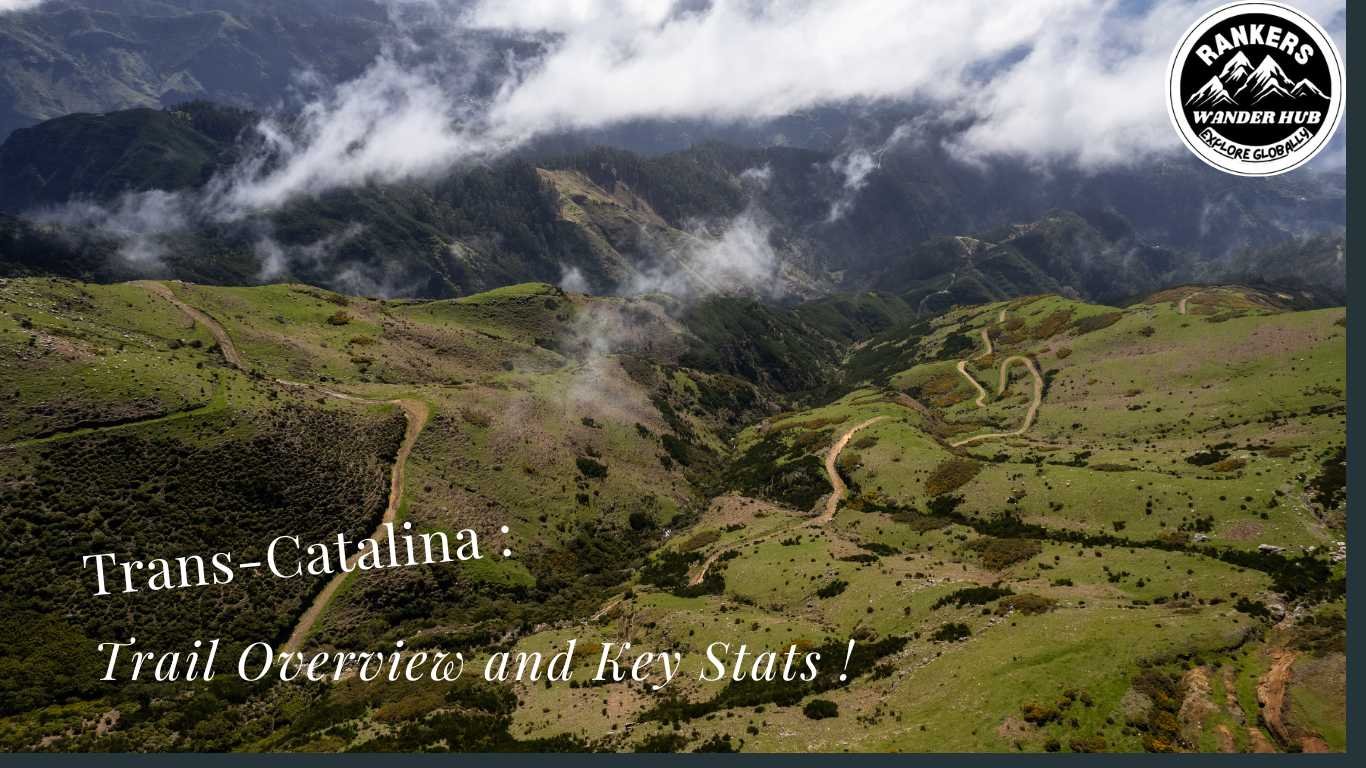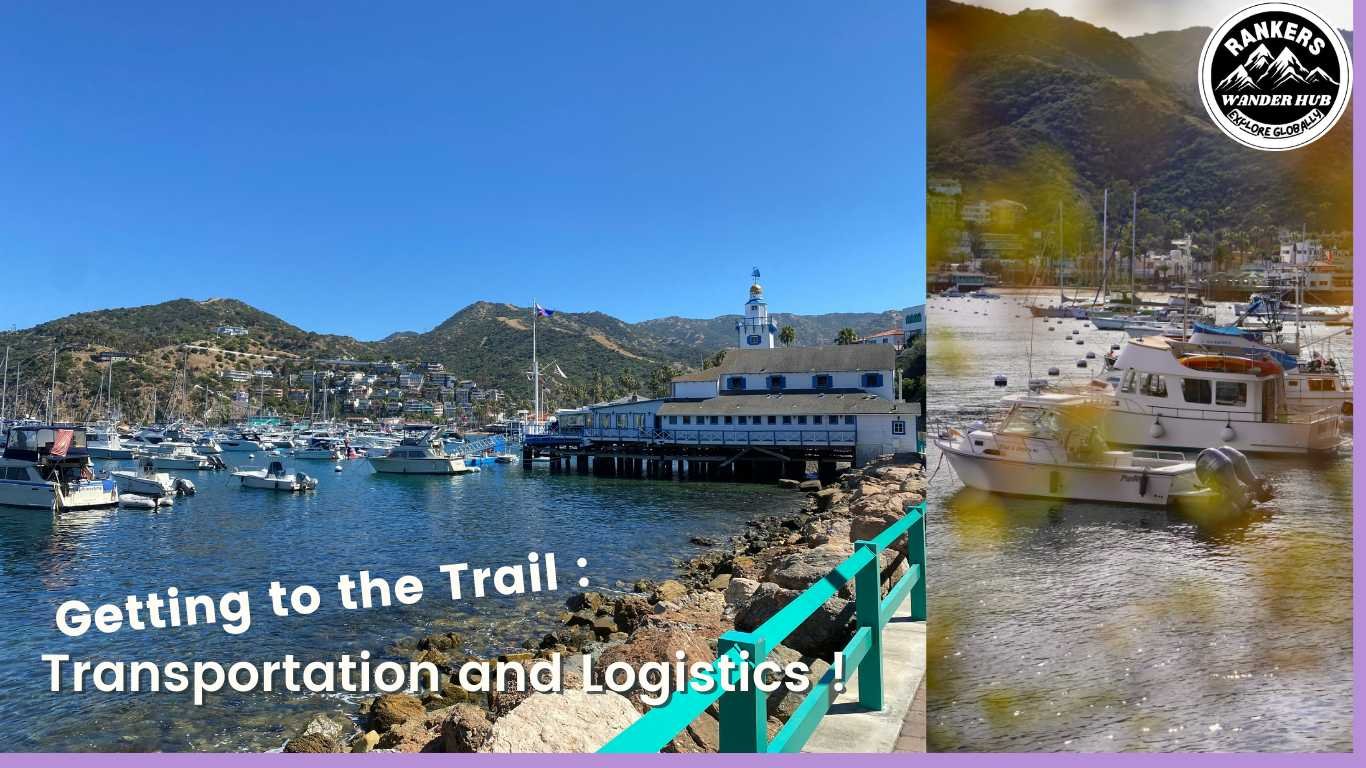Trans-Catalina Trail Overview and Key Stats;
The Trans-Catalina Trail is a stunning 47-mile backpacking journey across Catalina Island, offering an unforgettable experience in the 42,000-acre Nature Preserve. This trail is perfect for those who want to challenge themselves with rugged terrain and experience the beauty of flora and fauna found only on this island. It spans from Avalon to Parsons Landing, passing through Two Harbors and Divide Road, and offers a range of elevation gains—the highest being 1,748 feet.
Expect a round trip of about 38.5 miles and over 8,000 feet of elevation gain. The trail gives you a chance to observe bison roaming the hills, while you walk along winding paths with scenic views of the island’s coastline and rugged terrain. For those planning to take the plunge, make sure you’re prepared for the tough parts—especially if you’re new to backpacking. The trek will take about a week, depending on your fitness level.
Camping, Permits, and Reservations
Planning to stay overnight? You’ll need to secure camping reservations and obtain permits. The trail offers primitive camping options at Hermit Gulch Campground, Blackjack Campground, and Two Harbors Camping, as well as more secluded spots like Parsons Landing. These campsites are designed for those who enjoy a basic camping experience, so expect to pack everything in—firewood, water jugs, and your own tent.
- Hermit Gulch has running water and showers for a more comfortable stay.
- Blackjack provides a picnic table, fire pits, and a fun tire swing to relax after a long day on the trail.
Campsites are available through the Santa Catalina Island Company and Reserve America, with prices ranging from $30 to $110 per night. The off-season offers waived minimum stays, so you might find a quieter spot during the winter months. For the best experience, make sure to plan ahead, especially during the peak season when spots fill up fast.
Key Trail Stats
The Trans-Catalina Trail isn’t just about beautiful views—it’s also about fitness and endurance. With a total elevation gain of 9,600 feet, this trail is definitely a challenge. Starting from Avalon, you’ll pass through Two Harbors and reach the highest point at 1,748 feet. It’s ideal for those looking to test their limits but can be tough if you’re not used to long-distance hikes.

[“Explore the Trans-Catalina Trail, with scenic views of Catalina Island’s mountains and trails. Get an overview and key stats for your next adventure at Rankers WanderHub.”]
Transportation and Getting There
Getting to the Trans-Catalina Trail is half the fun! To reach Catalina Island, take the Catalina Express ferry from San Pedro, Long Beach, or Dana Point. The ferry ride takes only one hour and gives you the perfect preview of the island’s beauty. Once you arrive, you’ll be on island time, where your journey begins.
You can also opt for a helicopter ride if you’re feeling adventurous, but the ferry is the most common and affordable option. From there, a shuttle service or walk will get you to the trailhead, where your backpacking adventure truly starts.
Final Tips for Hiking the Trans-Catalina Trail
- Fitness Level: Prepare for a mix of steep ascents and descents, so some training is recommended. Make sure to pace yourself and take breaks.
- Water Sources: Always have a filter for emergencies—water sources are limited at certain points.
- Food: There are limited food options along the trail. Stock up on lightweight snacks, tacos, and snacks from local stores like the Two Harbors Visitor Center.
- Permits: Don’t forget to make reservations early, especially during the peak season. Book through the Santa Catalina Island Company or Reserve America.
Transportation and Logistics: Getting to the Trail
When planning your backpacking adventure along the Trans-Catalina Trail, understanding the logistics and transportation options is essential. The easiest way to reach Catalina Island is by taking the Catalina Express ferry. Ferries depart from San Pedro, Long Beach, and Dana Point, with a round trip costing around $92. The ferry ride is quick—just about an hour—giving you a great view of the island as you approach.
If you’re bringing a vehicle, there is parking available at the terminals, typically at a cost of $18 per day. Alternatively, you can opt for a helicopter ride for a unique, though pricier, option to reach the island.
Once on the island, you’ll need to arrange for shuttles to get to Avalon or Two Harbors. During the late spring and fall, these services can be seasonal, so it’s important to check schedules in advance. Many hikers also use services like Uber or Lyft for quick transport, especially if they plan to start their trek early in the morning, for an alpine start. With all these options, you can plan a timeline that fits your itinerary.

{“Discover the best way to reach the trailhead at Catalina Island, with stunning views of the harbor, boats, and scenic landscapes. Plan your journey with Rankers WanderHub.”}
Packing Essentials for the Trans Catalina Trail
Packing smart is key to making the most of your backpacking experience on the Trans-Catalina Trail. Here’s a list of backpacking gear to help ensure you’re fully prepared:
- 40-liter backpack: Just the right size to carry everything you need without overloading.
- 3-liter water bladder: Stay hydrated as you trek through the island’s rugged terrain.
- Lightweight tent: Opt for something compact but durable.
- Sleeping bag (3-season, 30°F): Perfect for cool nights on the island, especially in the higher elevations.
- Sleeping pad: Essential for comfort during your camping nights.
- Trekking poles: These will save your knees on those tough elevation changes.
- Sturdy footwear: You’ll need durable shoes or boots for the rocky, uneven paths.
- Sunscreen and sun hat: Protect yourself from the sun, especially in exposed areas.
- Bug spray: The island’s wilderness means you’ll want to ward off bugs.
- Headlamp and batteries: For night hiking or campsite tasks.
- Portable stove (like Jetboil): To prepare hot meals or boil water.
- Spork, fire starter, first aid kit: Always good to have on hand in case of an emergency.
- GPS device and maps: Even if you’re a seasoned hiker, it’s wise to have navigation tools.
- Offline apps and phone: For emergency communication, if needed.
- Sunglasses, wool socks, rain shell: Prepare for weather changes, and keep your eyes protected.
Additionally, consider packing snacks and dehydrated meals to refuel during the hike. A battery pack is always handy for keeping electronics charged, especially if you plan on using a Kindle for reading during breaks.
Itinerary Options: Planning Your Hike
The Trans-Catalina Trail offers a range of itinerary options depending on your time and stamina. A classic option is to complete the trail in 5 days and 4 nights, camping at spots like Blackjack Campground, Little Harbor, and Parsons Landing. This gives you plenty of time to enjoy the stunning views and the island’s wild flora and fauna. For those who prefer a quicker pace, the 3-day, 2-night itinerary is another great choice, covering Avalon to Two Harbors.
If you want to avoid the crowds, you can hike the trail in reverse, starting at Two Harbors and heading toward Avalon. This might involve a bit more climbing, but the remote sections can be less populated and offer a more peaceful experience. Either way, you’ll find the elevation changes manageable as long as you pace yourself and take breaks when needed.
A well-planned itinerary will help you tackle this adventure with confidence, ensuring you get the most out of your time on the Trans-Catalina Trail. Whether you’re looking for a challenging hike or a more relaxed pace, there’s an option for you to explore.
Best Time to Hike the Trans Catalina Trail
Planning the best time to hike the Trans-Catalina Trail is crucial for a smooth and enjoyable experience. Luckily, this trail is accessible year-round, though certain seasons offer more advantages depending on your preferences.
- Winter (December to February): The cooler temperatures make hiking more comfortable, especially when compared to the heat of the summer. The dry season ensures you won’t be stuck in rainfall. However, be aware that there are fewer rowdy backpackers during this period, meaning you can enjoy the solitude of the island.
- Spring (March to May): This is often regarded as the best time to hike the trail. The wildflowers—including purple arroyo, lupine, paintbrush, and poppies—are in full bloom, transforming the landscape into a colorful wonderland. Additionally, the exposed trail sections benefit from some shade and tree coverage during this time.
- Summer (June to August): While summer offers the longest days and good weather, it’s also the most crowded time. The trail can feel busier, especially around Two Harbors and Avalon. Temperatures can be higher, so make sure you have proper sun protection.
- Off-season (October to November): Another good option is the offseason, especially in October when the island is a little quieter, and you can experience the island without the crowds. The weather is still pleasant, but keep in mind that wildflowers from spring may no longer be in bloom.
In summary, if you want to see the best of the island’s beauty, spring is your go-to season. But if solitude and cooler temperatures are your priority, then winter might be your ideal time to visit.
Safety and Wildlife: Hiking Smart on Catalina Island
Safety is always the top priority when hiking on the Trans-Catalina Trail. The island is home to unique wildlife, including bison, rattlesnakes, and foxes, so it’s important to be prepared.
- Bison: These majestic creatures roam the rugged terrain and can be encountered along the trail. Keep a safe distance, and never try to approach them.
- Rattlesnakes: These are another common sight, especially in the warmer months. Always be alert, especially when hiking in the sun or near rocks. Carry trekking poles to help with stability, especially when navigating uphill or downhill sections.
- Foxes: Island Foxes are curious and may come close to your campsite. Store food safely in critter boxes or bear canisters to prevent any unwanted visitors.
Make sure to stay hydrated, especially in dry conditions. Use electrolytes like Nuun tablets to replenish essential salts lost through sweat. It’s also a good idea to avoid direct exposure to the sun for long periods and take breaks in the shade when possible. Pay attention to trail erosion and landslides, as some sections can be tricky in bad weather conditions.
By keeping these safety tips in mind, you’ll be ready to face the trail confidently.
Day-by-Day Trail Notes: What to Expect Each Day
Here’s a quick look at what to expect as you trek across the Trans-Catalina Trail, from the first step in San Pedro to your final destination in Avalon.
- Day 1: Start at San Pedro and head towards Two Harbors. Along the way, you’ll pass the iconic Vincent Thomas Bridge, where you’ll see views of the cranes and container ships. The day includes a chance to spot wildlife, such as Island Foxes.
- Day 2: From Two Harbors, continue your hike to Parsons Landing, where you can set up camp. This section offers turquoise water views and a primitive beach to enjoy. Make sure to have your dehydrated meals ready for a simple but hearty dinner.
- Day 3: Continue on to Little Harbor and Shark Harbor. Along this stretch, you can expect views of wildflowers and perhaps even a glimpse of a bison in the distance. The day might end with a treat—Buffalo tacos or cookies from local eateries.
- Day 4: The final stretch leads you to Avalon, where you’ll enjoy the lush and green scenery. Here, you can relax and enjoy some refreshing drinks at places like Buffalo Milk bar before heading back.
Throughout the hike, take in the red sky sunsets and enjoy your Mountain House brunch or snacks like trail mix, salami, and cheese. Whether you’re sitting at a picnic table or resting near Shark Harbor, the experience will leave you with memories of Catalina’s raw beauty.
Trail Maps and Navigation: Staying on Track
Navigating the Trans-Catalina Trail requires a bit of preparation. There are several tools available to make your trip easier, whether you’re an experienced backpacker or a first-timer.
- Trail maps are available through various sources, including National Geographic and Tom Harrison. Many hikers recommend using interactive maps for turn-by-turn directions.
- GPS devices or apps like GAIA GPS and AllTrails+ are invaluable for ensuring accurate navigation on the trail. Offline apps are a must, especially if you find yourself in areas with no signal.
- For those who prefer a traditional approach, paper maps from the Catalina Conservancy are available for free at the Visitor Information centers.
The elevation profile on these maps helps hikers understand the split forks in the trail and know where they’ll be tackling the highest point of the trail. Be sure to download GPX files in advance for even more accurate trail guidance.
Campground Options: Where to Stay Along the Trail
Finding the right campsites is crucial when backpacking the Trans-Catalina Trail. The island offers several campgrounds with different amenities, and each has something unique to offer.
- Hermit Gulch Campground: This campground is located near Avalon and is perfect for those looking to be close to town while still enjoying a peaceful environment. It offers primitive tents, cabins, picnic tables, and fire pits for cozy evenings. While it doesn’t have ocean views, it’s a short walk from Avalon’s main area and has potable water and outdoor showers.
- Blackjack Campground: Located a bit further inland, this campsite is ideal for those who prefer the rugged terrain and mountainous views of Catalina. It’s more secluded and offers primitive tents, firewood, and great views of the island. With no showers, it’s a more rustic experience but perfect for backpacking.
- Little Harbor Campground: If you’re looking for a secluded spot with access to the beach, Little Harbor is the place to go. You can enjoy the sand, take a swim, and relax while having access to potable water, chemical toilets, and shade structures. Kayak rentals are available for those interested in exploring the coastline.
- Shark Harbor: This campground is known for its small and secluded setting. It’s a great spot for those who want to enjoy a quieter experience away from the more popular areas like Two Harbors. There are picnic tables and fire pits where you can enjoy meals with a view of the ocean.
- Two Harbors Campground: A more populated spot with easy access to both Two Harbors and nearby Parsons Landing, this campground has water sources, outdoor showers, and fire pits. It’s a great place for those looking to be close to town while still enjoying a bit of nature.
- Parsons Landing: One of the most remote spots, Parsons Landing offers beach access with sand and bluff views. It’s perfect for a peaceful night under the stars, with firewood available and picnic tables for enjoying meals by the sea.
Water and Food Availability Along the Trail
Staying hydrated and well-fed is vital during your trek across the Trans-Catalina Trail. Here’s everything you need to know about water and food availability.
- Water sources: The trail is equipped with several water sources where you can fill up your water bladder. You’ll find potable water at places like Avalon, Blackjack Campground, Airport in the Sky, Little Harbor, Two Harbors, and Parsons Landing. Most of these locations offer cached water in firewood bundles or lockers.
- Food options: For those who prefer to travel light, you can pack dehydrated dinners from brands like Mountain House or lighter snacks such as trail mix or energy bars. If you’re craving something hearty, enjoy a bison burger or a delicious Thai curry at places like Harbor Reef or DC-3. Don’t forget to stop by for a $1 taco and $2 beer during happy hour!
- Restocking on the trail: If you run low on supplies, you can restock at Avalon Vons, where you’ll find fresh food and other essentials. There are also general stores at Two Harbors where you can grab a bite or even rent a kayak for a scenic adventure.
Budgeting for the Trans Catalina Trail: Costs You Should Know
When planning your backpacking trip along the Trans-Catalina Trail, it’s essential to know the budget and the associated costs. From ferry rides to campground fees, understanding the expenses will help you prepare for the journey.
- Ferry Ride: The most significant cost for your trip will be the ferry. The round trip fare from San Pedro to Avalon typically costs $92. Be sure to check for deals or discounts if you’re traveling in the off-season.
- Parking Fees: Parking at the San Pedro terminal costs about $18 per day. If you’re planning to leave your car for multiple days, this is an important cost to factor in.
- Campground Fees: Each campground along the trail has a different campground fee. For example, Blackjack Campground is around $42.25, while Little Harbor charges $55.39 per night. If you’re heading to Parsons Landing, expect to pay $78.63.
- Firewood and Meals: You’ll also need to account for firewood purchases and meals along the way. At places like Avalon or Two Harbors, meals and snacks can add to your expenses, such as a $1 taco during happy hour.
- Shuttle Bus and Taxi: For transportation, you might need to use a shuttle bus or taxi, especially if you’re returning from Two Harbors. The taxi ride can get pricey, so budget for that as well.
- Lodging: If you’re staying at places like Hermit Gulch, expect to pay $134.69 for a cabin or tent rental. You can also enjoy off-season discounts for extra nights, making it a great option for a more relaxed stay.
Wildlife and Safety: Stay Safe While Enjoying Nature
As you hike the Trans-Catalina Trail, you’ll encounter stunning wildlife, but it’s essential to know how to stay safe on the trail.
- Wildlife: The island is home to several species of animals, including bison, island foxes, and various shorebirds. While these creatures add to the experience, it’s important to respect their space. Carry a buffalo safety sheet to understand what to do if you come across bison.
- Safety Measures: Use trekking poles for stability, especially during uphill and downhill treks. This helps prevent falls, especially on loose gravel or steep ascents. Also, carry hydration supplies, electrolytes, and sunscreen to protect yourself from the harsh sun. The trail can get dry, so make sure you stay hydrated and protect your skin.
- Food Storage: Use critter boxes or food storage methods to keep your meals safe from wildlife. Keep your food secure, as animals like foxes and bison may try to raid your supplies.
- Prepare for Weather: Weather changes quickly on the island, so pack accordingly. Bring a first aid kit, proper footwear, and gear for trail erosion or landslides. Prepare for any situation to ensure you’re safe while hiking.
Memorable Highlights: What You Shouldn’t Miss
The Trans-Catalina Trail offers some unforgettable views and experiences that you don’t want to miss. Here are a few key highlights to remember:
- Avalon and Two Harbors: Whether you start in Avalon or Two Harbors, these towns offer charming experiences. Don’t miss a chance to explore Starlight Beach, enjoy the sunsets, and take in the turquoise water and lush greenery around you.
- Bison Sightings: As you hike, you’re likely to encounter bison roaming the rolling hills. These moments will leave you with lasting memories of the wild beauty of Catalina Island.
- Shark Harbor: Shark Harbor offers secluded coves with stunning coastal views. Perfect for those looking for a quiet spot to relax or take in the scenery.
- Island Foxes and Campfires: At the end of the day, nothing beats a campfire, especially with the backdrop of Island Foxes darting around and the sound of the waves crashing. Make sure to try some DC-3 tacos and soak in the camping experience with fellow hikers.
- Bucket List Adventure: Hiking the Trans-Catalina Trail is truly a bucket list adventure. It’s a great way to experience the wilderness of Southern California, enjoy the unique adventure of backpacking, and cross off a big goal.


2 thoughts on ““Ultimate Guide: Backpacking the Trans Catalina Trail””
Comments are closed.